position sensor SUBARU CROSSTREK 2018 Owners Manual
[x] Cancel search | Manufacturer: SUBARU, Model Year: 2018, Model line: CROSSTREK, Model: SUBARU CROSSTREK 2018Pages: 474, PDF Size: 20.76 MB
Page 50 of 474
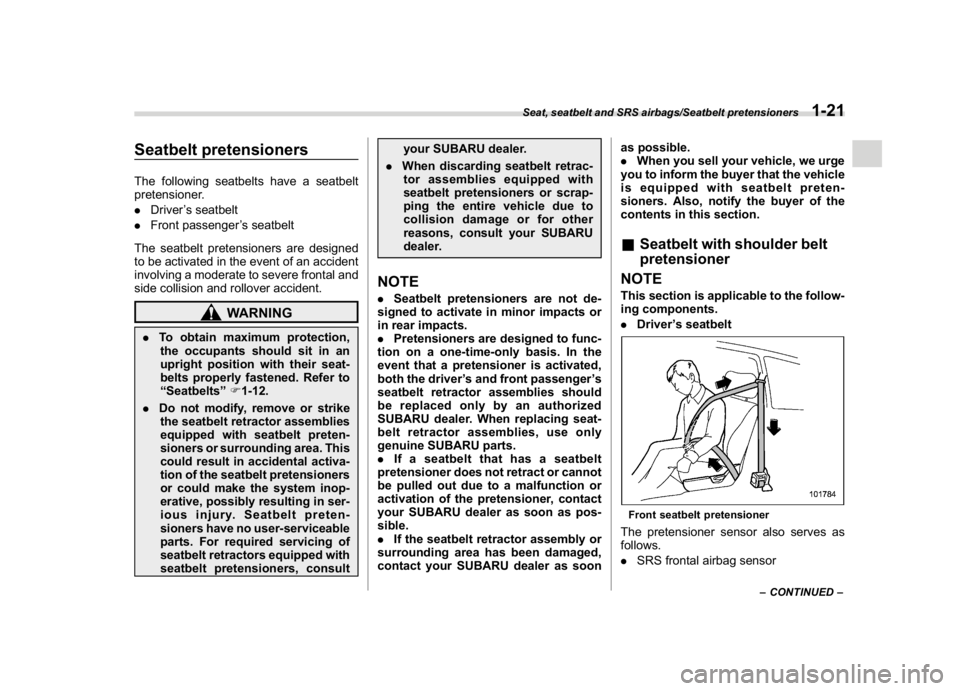
(51,1)
北米Model "A1320BE-C" EDITED: 2017/ 10/ 10
Seatbelt pretensionersThe following seatbelts have a seatbelt
pretensioner.
.Driver’s seatbelt
.Front passenger’s seatbelt
The seatbelt pretensioners are designed
to be activated in the event of an accident
involving a moderate to severe frontal and
side collision and rollover accident.
WARNING
.To obtain maximum protection,
the occupants should sit in an
upright position with their seat-
belts properly fastened. Refer to
“Seatbelts”F1-12.
.Do not modify, remove or strike
the seatbelt retractor assemblies
equipped with seatbelt preten-
sioners or surrounding area. This
could result in accidental activa-
tion of the seatbelt pretensioners
or could make the system inop-
erative, possibly resulting in ser-
ious injury. Seatbelt preten-
sioners have no user-serviceable
parts. For required servicing of
seatbelt retractors equipped with
seatbelt pretensioners, consultyour SUBARU dealer.
.When discarding seatbelt retrac-
tor assemblies equipped with
seatbelt pretensioners or scrap-
ping the entire vehicle due to
collision damage or for other
reasons, consult your SUBARU
dealer.
NOTE.Seatbelt pretensioners are not de-
signed to activate in minor impacts or
in rear impacts.
.Pretensioners are designed to func-
tion on a one-time-only basis. In the
event that a pretensioner is activated,
both the driver’s and front passenger’s
seatbelt retractor assemblies should
be replaced only by an authorized
SUBARU dealer. When replacing seat-
belt retractor assemblies, use only
genuine SUBARU parts.
.If a seatbelt that has a seatbelt
pretensioner does not retract or cannot
be pulled out due to a malfunction or
activation of the pretensioner, contact
your SUBARU dealer as soon as pos-
sible.
.If the seatbelt retractor assembly or
surrounding area has been damaged,
contact your SUBARU dealer as soonas possible.
.When you sell your vehicle, we urge
you to inform the buyer that the vehicle
is equipped with seatbelt preten-
sioners. Also, notify the buyer of the
contents in this section.
&Seatbelt with shoulder belt
pretensioner
NOTEThis section is applicable to the follow-
ing components.
.Driver’s seatbeltFront seatbelt pretensionerThe pretensioner sensor also serves as
follows.
.SRS frontal airbag sensor
–CONTINUED–
Seat, seatbelt and SRS airbags/Seatbelt pretensioners
1-21
1
Page 77 of 474

(78,1)
北米Model "A1320BE-C" EDITED: 2017/ 10/ 10
!Front passenger’s SRS frontal air-
bag
The front passenger’s SRS frontal airbag
uses a dual stage inflator. The inflator
operates in different ways depending on
the severity of impact.1) Occupant detection sensorsThe occupant detection system sensors
are installed between the seat and seat
rails, and monitor the physique and pos-
ture of the front passenger. Using this
information, the occupant detection sys-
tem determines whether the front passen-
ger’s SRS frontal airbag should be de-
ployed or not.
The occupant detection system may not
inflate the front passenger’s SRS frontal
airbag even when the driver’s SRS frontalairbag deploys. This is normal. In this
case, although the front passenger’s SRS
frontal airbag does not operate, the front
passenger’s seatbelt pretensioner oper-
ates with the driver’s seatbelt preten-
sioner. For details about the seatbelt
pretensioner, refer to“Seatbelt preten-
sioners”F1-21.
CAUTION
Observe the following precautions.
Failure to do so may prevent the
SUBARU advanced frontal airbag
system from functioning correctly
or cause the system to fail.
.Do not apply any strong impact to
the front passenger’s seat such
as by kicking.
.Do not let rear passengers rest
their feet between the front seat-
back and seat cushion.
.Do not spill liquid on the front
passenger’s seat. If liquid is
spilled, wipe it off immediately.
.Do not remove or disassemble
the front passenger’s seat.
.Do not install any accessory
(such as an audio amplifier) other
than a genuine SUBARU acces-
sory under the front passenger’sseat.
.Do not place anything (shoes,
umbrella, etc.) under the front
passenger’s seat.
.Do not place any objects (books,
etc.) around the front passen-
ger’s seat.
.Do not use the front passenger’s
seat with the head restraint re-
moved.
.Do not leave any articles on the
front passenger’s seat or the
seatbelt tongue and buckle en-
gaged when you leave your vehi-
cle.
.Do not put sharp object(s) on the
seat or pierce the seat uphols-
tery.
.Do not place a magnet near the
seatbelt buckle and the seatbelt
retractor.
.Do not use front seats with their
forward-backward position and
seatback not being locked into
place securely. If any of them are
not locked securely, adjust them
again. For adjusting procedure,
refer to“Forward and backward
adjustment”F1-5 and“Reclining
the seatback”F1-5.
Seat, seatbelt and SRS airbags/SRS airbag (Supplemental Restraint System airbag)
1-48
Page 83 of 474
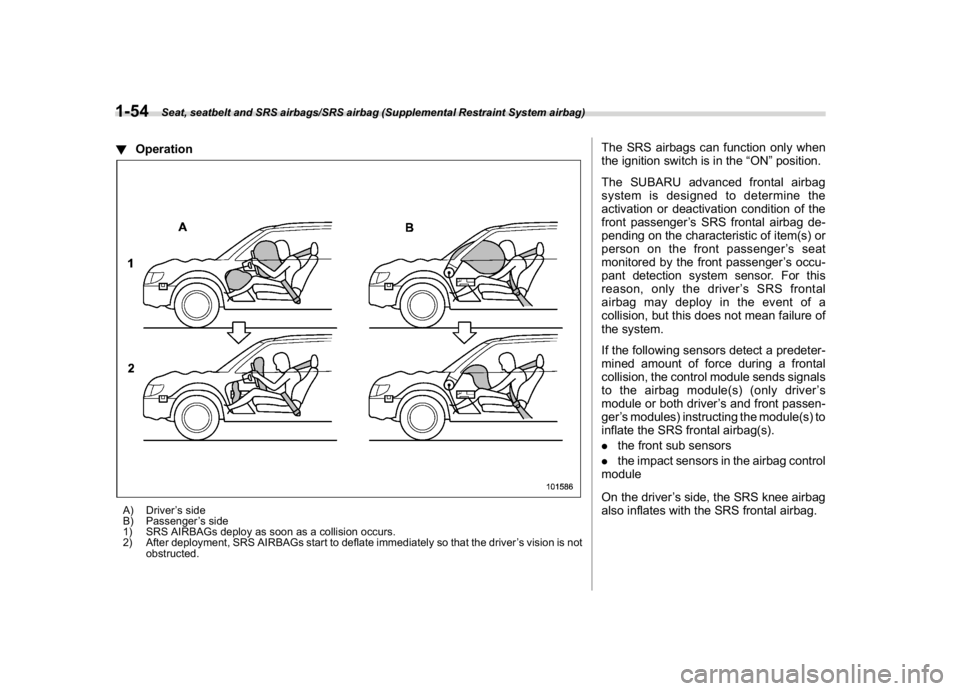
(84,1)
北米Model "A1320BE-C" EDITED: 2017/ 10/ 10
!OperationA) Driver’s side
B) Passenger’s side
1) SRS AIRBAGs deploy as soon as a collision occurs.
2) After deployment, SRS AIRBAGs start to deflate immediately so that the driver’s vision is not
obstructed.
The SRS airbags can function only when
the ignition switch is in the“ON”position.
The SUBARU advanced frontal airbag
system is designed to determine the
activation or deactivation condition of the
front passenger’s SRS frontal airbag de-
pending on the characteristic of item(s) or
person on the front passenger’s seat
monitored by the front passenger’s occu-
pant detection system sensor. For this
reason, only the driver’s SRS frontal
airbag may deploy in the event of a
collision, but this does not mean failure of
the system.
If the following sensors detect a predeter-
mined amount of force during a frontal
collision, the control module sends signals
to the airbag module(s) (only driver’s
module or both driver’s and front passen-
ger’s modules) instructing the module(s) to
inflate the SRS frontal airbag(s).
.the front sub sensors
.the impact sensors in the airbag control
module
On the driver’s side, the SRS knee airbag
also inflates with the SRS frontal airbag.
Seat, seatbelt and SRS airbags/SRS airbag (Supplemental Restraint System airbag)
1-54
Page 88 of 474
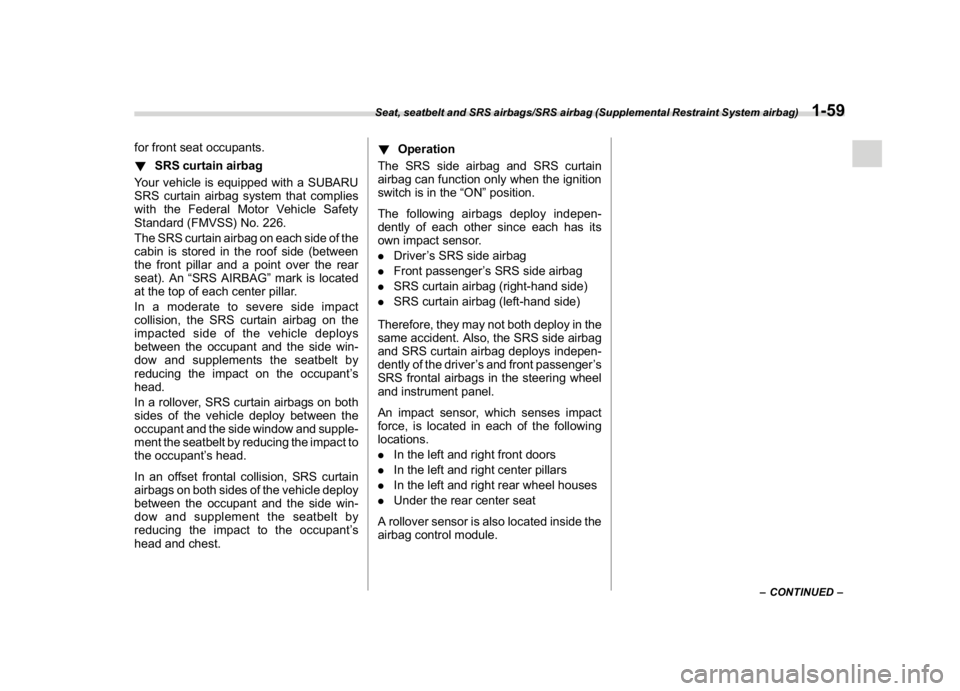
(89,1)
北米Model "A1320BE-C" EDITED: 2017/ 10/ 10
for front seat occupants.
!SRS curtain airbag
Your vehicle is equipped with a SUBARU
SRS curtain airbag system that complies
with the Federal Motor Vehicle Safety
Standard (FMVSS) No. 226.
The SRS curtain airbag on each side of the
cabin is stored in the roof side (between
the front pillar and a point over the rear
seat). An“SRS AIRBAG”mark is located
at the top of each center pillar.
Inamoderatetoseveresideimpact
collision, the SRS curtain airbag on the
impacted side of the vehicle deploys
between the occupant and the side win-
dow and supplements the seatbelt by
reducing the impact on the occupant’s
head.
In a rollover, SRS curtain airbags on both
sides of the vehicle deploy between the
occupant and the side window and supple-
ment the seatbelt by reducing the impact to
the occupant’s head.
In an offset frontal collision, SRS curtain
airbags on both sides of the vehicle deploy
between the occupant and the side win-
dow and supplement the seatbelt by
reducing the impact to the occupant’s
head and chest.!Operation
The SRS side airbag and SRS curtain
airbag can function only when the ignition
switch is in the“ON”position.
The following airbags deploy indepen-
dently of each other since each has its
own impact sensor.
.Driver’s SRS side airbag
.Front passenger’s SRS side airbag
.SRS curtain airbag (right-hand side)
.SRS curtain airbag (left-hand side)
Therefore, they may not both deploy in the
same accident. Also, the SRS side airbag
and SRS curtain airbag deploys indepen-
dently of the driver’s and front passenger’s
SRS frontal airbags in the steering wheel
and instrument panel.
An impact sensor, which senses impact
force, is located in each of the following
locations.
.In the left and right front doors
.In the left and right center pillars
.In the left and right rear wheel houses
.Under the rear center seat
A rollover sensor is also located inside the
airbag control module.
–CONTINUED–
Seat, seatbelt and SRS airbags/SRS airbag (Supplemental Restraint System airbag)
1-59
1
Page 96 of 474
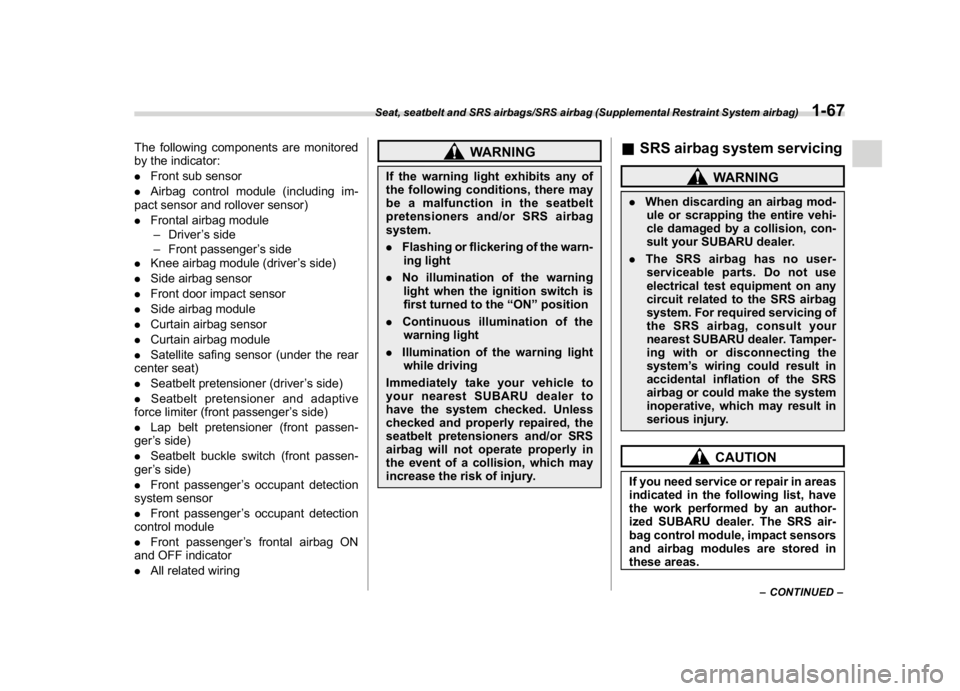
(97,1)
北米Model "A1320BE-C" EDITED: 2017/ 10/ 10
The following components are monitored
by the indicator:
.Front sub sensor
.Airbag control module (including im-
pact sensor and rollover sensor)
.Frontal airbag module
–Driver’s side
–Front passenger’s side
.Knee airbag module (driver’s side)
.Side airbag sensor
.Front door impact sensor
.Side airbag module
.Curtain airbag sensor
.Curtain airbag module
.Satellite safing sensor (under the rear
center seat)
.Seatbelt pretensioner (driver’s side)
.Seatbelt pretensioner and adaptive
force limiter (front passenger’s side)
.Lap belt pretensioner (front passen-
ger’s side)
.Seatbelt buckle switch (front passen-
ger’s side)
.Front passenger’s occupant detection
system sensor
.Front passenger’s occupant detection
control module
.Front passenger’s frontal airbag ON
and OFF indicator
.All related wiring
WARNING
If the warning light exhibits any of
the following conditions, there may
be a malfunction in the seatbelt
pretensioners and/or SRS airbag
system.
.Flashing or flickering of the warn-
ing light
.No illumination of the warning
light when the ignition switch is
first turned to the“ON”position
.Continuous illumination of the
warning light
.Illumination of the warning light
while driving
Immediately take your vehicle to
your nearest SUBARU dealer to
have the system checked. Unless
checked and properly repaired, the
seatbelt pretensioners and/or SRS
airbag will not operate properly in
the event of a collision, which may
increase the risk of injury.
&SRS airbag system servicing
WARNING
.When discarding an airbag mod-
ule or scrapping the entire vehi-
cle damaged by a collision, con-
sult your SUBARU dealer.
.The SRS airbag has no user-
serviceable parts. Do not use
electrical test equipment on any
circuit related to the SRS airbag
system. For required servicing of
the SRS airbag, consult your
nearest SUBARU dealer. Tamper-
ingwithordisconnectingthe
system’s wiring could result in
accidental inflation of the SRS
airbag or could make the system
inoperative, which may result in
serious injury.
CAUTION
If you need service or repair in areas
indicated in the following list, have
the work performed by an author-
ized SUBARU dealer. The SRS air-
bag control module, impact sensors
and airbag modules are stored in
these areas.
–CONTINUED–
Seat, seatbelt and SRS airbags/SRS airbag (Supplemental Restraint System airbag)
1-67
1
Page 106 of 474
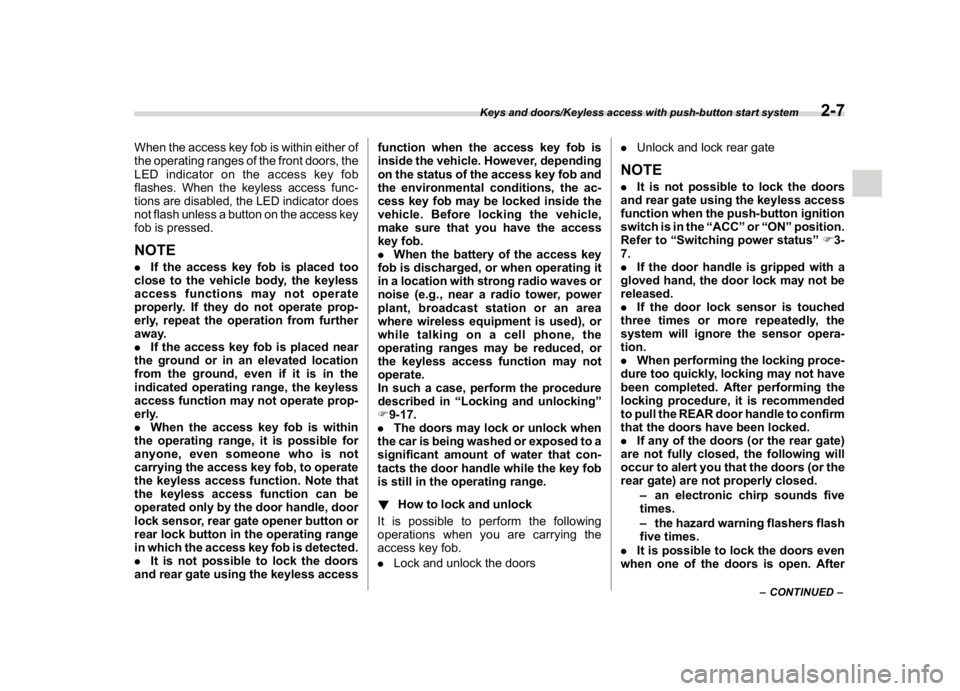
(109,1)
北米Model "A1320BE-C" EDITED: 2017/ 10/ 10
When the access key fob is within either of
the operating ranges of the front doors, the
LED indicator on the access key fob
flashes. When the keyless access func-
tions are disabled, the LED indicator does
not flash unless a button on the access key
fob is pressed.NOTE.If the access key fob is placed too
close to the vehicle body, the keyless
access functions may not operate
properly. If they do not operate prop-
erly, repeat the operation from further
away.
.If the access key fob is placed near
the ground or in an elevated location
from the ground, even if it is in the
indicated operating range, the keyless
access function may not operate prop-
erly.
.When the access key fob is within
the operating range, it is possible for
anyone, even someone who is not
carrying the access key fob, to operate
the keyless access function. Note that
the keyless access function can be
operated only by the door handle, door
lock sensor, rear gate opener button or
rear lock button in the operating range
in which the access key fob is detected.
.It is not possible to lock the doors
and rear gate using the keyless accessfunction when the access key fob is
inside the vehicle. However, depending
on the status of the access key fob and
the environmental conditions, the ac-
cess key fob may be locked inside the
vehicle. Before locking the vehicle,
make sure that you have the access
key fob.
.When the battery of the access key
fob is discharged, or when operating it
in a location with strong radio waves or
noise (e.g., near a radio tower, power
plant, broadcast station or an area
where wireless equipment is used), or
while talking on a cell phone, the
operating ranges may be reduced, or
the keyless access function may not
operate.
In such a case, perform the procedure
described in“Locking and unlocking”
F9-17.
.The doors may lock or unlock when
the car is being washed or exposed to a
significant amount of water that con-
tacts the door handle while the key fob
is still in the operating range.
!How to lock and unlock
It is possible to perform the following
operations when you are carrying the
access key fob.
.Lock and unlock the doors.Unlock and lock rear gate
NOTE.It is not possible to lock the doors
and rear gate using the keyless access
function when the push-button ignition
switch is in the“ACC”or“ON”position.
Refer to“Switching power status”F3-
7.
.If the door handle is gripped with a
gloved hand, the door lock may not be
released.
.If the door lock sensor is touched
three times or more repeatedly, the
system will ignore the sensor opera-
tion.
.When performing the locking proce-
dure too quickly, locking may not have
been completed. After performing the
locking procedure, it is recommended
to pull the REAR door handle to confirm
that the doors have been locked.
.If any of the doors (or the rear gate)
are not fully closed, the following will
occur to alert you that the doors (or the
rear gate) are not properly closed.
–an electronic chirp sounds five
times.
–the hazard warning flashers flash
five times.
.It is possible to lock the doors even
when one of the doors is open. After
–CONTINUED–
Keys and doors/Keyless access with push-button start system
2-7
2
Page 110 of 474
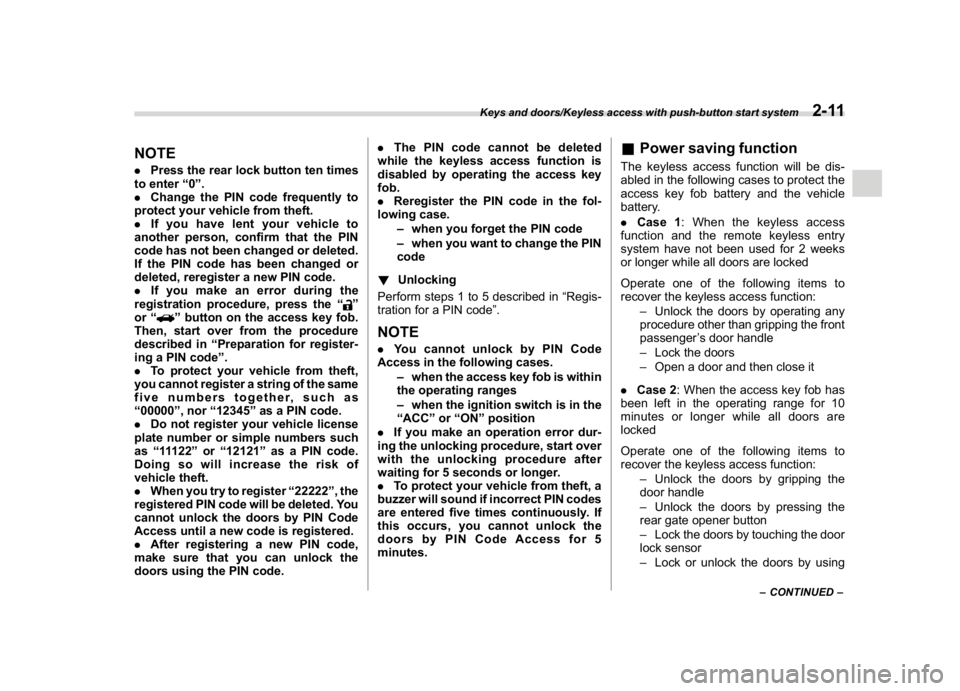
(113,1)
北米Model "A1320BE-C" EDITED: 2017/ 10/ 10
NOTE.Press the rear lock button ten times
to enter“0”.
.Change the PIN code frequently to
protect your vehicle from theft.
.If you have lent your vehicle to
another person, confirm that the PIN
code has not been changed or deleted.
If the PIN code has been changed or
deleted, reregister a new PIN code.
.If you make an error during the
registration procedure, press the“
”
or“
”button on the access key fob.
Then, start over from the procedure
described in“Preparation for register-
ing a PIN code”.
.To protect your vehicle from theft,
you cannot register a string of the same
five numbers together, such as
“00000”, nor“12345”as a PIN code.
.Do not register your vehicle license
plate number or simple numbers such
as“11122”or“12121”as a PIN code.
Doing so will increase the risk of
vehicle theft.
.When you try to register“22222”, the
registered PIN code will be deleted. You
cannot unlock the doors by PIN Code
Access until a new code is registered.
.After registering a new PIN code,
make sure that you can unlock the
doors using the PIN code..The PIN code cannot be deleted
while the keyless access function is
disabled by operating the access key
fob.
.Reregister the PIN code in the fol-
lowing case.
–when you forget the PIN code
–when you want to change the PIN
code
!Unlocking
Perform steps 1 to 5 described in“Regis-
tration for a PIN code”.
NOTE.You cannot unlock by PIN Code
Access in the following cases.
–when the access key fob is within
the operating ranges
–when the ignition switch is in the
“ACC”or“ON”position
.If you make an operation error dur-
ing the unlocking procedure, start over
with the unlocking procedure after
waiting for 5 seconds or longer.
.To protect your vehicle from theft, a
buzzer will sound if incorrect PIN codes
are entered five times continuously. If
this occurs, you cannot unlock the
doors by PIN Code Access for 5
minutes.
&Power saving functionThe keyless access function will be dis-
abled in the following cases to protect the
access key fob battery and the vehicle
battery.
.Case 1: When the keyless access
function and the remote keyless entry
system have not been used for 2 weeks
or longer while all doors are locked
Operate one of the following items to
recover the keyless access function:
–Unlock the doors by operating any
procedure other than gripping the front
passenger’s door handle
–Lock the doors
–Open a door and then close it
.Case 2: When the access key fob has
been left in the operating range for 10
minutes or longer while all doors are
locked
Operate one of the following items to
recover the keyless access function:
–Unlock the doors by gripping the
door handle
–Unlock the doors by pressing the
rear gate opener button
–Lock the doors by touching the door
lock sensor
–Lock or unlock the doors by using
–CONTINUED–
Keys and doors/Keyless access with push-button start system
2-11
2
Page 124 of 474
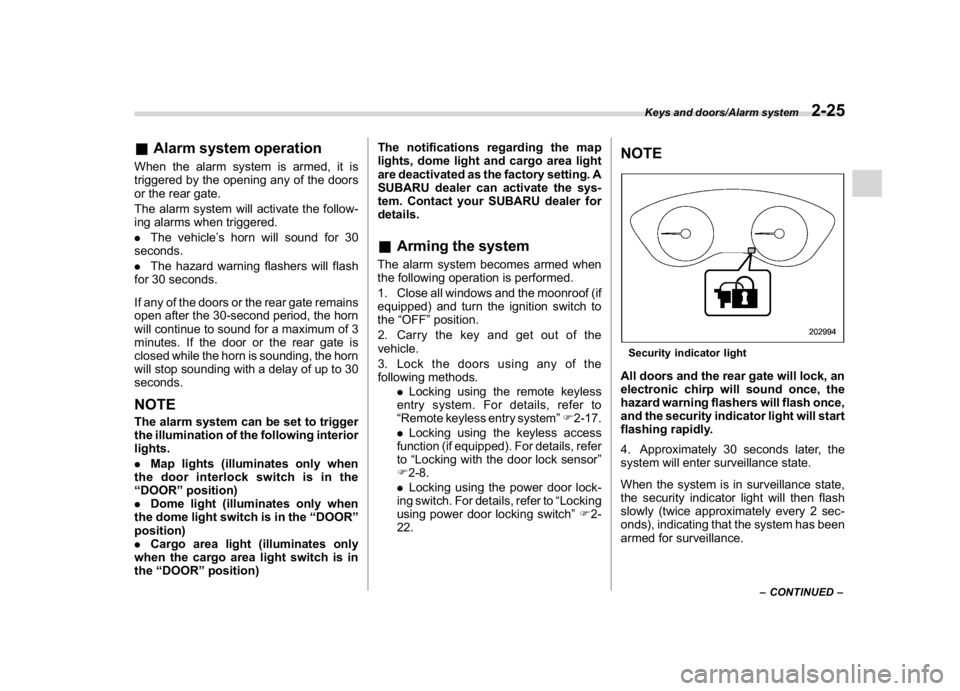
(127,1)
北米Model "A1320BE-C" EDITED: 2017/ 10/ 10
&Alarm system operationWhen the alarm system is armed, it is
triggered by the opening any of the doors
or the rear gate.
The alarm system will activate the follow-
ing alarms when triggered.
.The vehicle’s horn will sound for 30
seconds.
.The hazard warning flashers will flash
for 30 seconds.
If any of the doors or the rear gate remains
open after the 30-second period, the horn
will continue to sound for a maximum of 3
minutes. If the door or the rear gate is
closed while the horn is sounding, the horn
will stop sounding with a delay of up to 30
seconds.NOTEThe alarm system can be set to trigger
the illumination of the following interior
lights.
.Map lights (illuminates only when
the door interlock switch is in the
“DOOR”position)
.Dome light (illuminates only when
the dome light switch is in the“DOOR”
position)
.Cargo area light (illuminates only
when the cargo area light switch is in
the“DOOR”position)The notifications regarding the map
lights, dome light and cargo area light
are deactivated as the factory setting. A
SUBARU dealer can activate the sys-
tem. Contact your SUBARU dealer for
details.
&Arming the systemThe alarm system becomes armed when
the following operation is performed.
1. Close all windows and the moonroof (if
equipped) and turn the ignition switch to
the“OFF”position.
2. Carry the key and get out of the
vehicle.
3. Lock the doors using any of the
following methods.
.Locking using the remote keyless
entry system. For details, refer to
“Remote keyless entry system”F2-17.
.Locking using the keyless access
function (if equipped). For details, refer
to“Locking with the door lock sensor”
F2-8.
.Locking using the power door lock-
ing switch. For details, refer to“Locking
using power door locking switch”F2-
22.
NOTESecurity indicator lightAll doors and the rear gate will lock, an
electronic chirp will sound once, the
hazard warning flashers will flash once,
and the security indicator light will start
flashing rapidly.
4. Approximately 30 seconds later, the
system will enter surveillance state.
When the system is in surveillance state,
the security indicator light will then flash
slowly (twice approximately every 2 sec-
onds), indicating that the system has been
armed for surveillance.
–CONTINUED–
Keys and doors/Alarm system
2-25
2
Page 153 of 474

(158,1)
北米Model "A1320BE-C" EDITED: 2017/ 10/ 10
the TPMS is unable to monitor all
four road wheels. Contact your
SUBARU dealer as soon as possible
for tire and sensor replacement and/
or system resetting.
If the light illuminates steadily after
blinking for approximately one min-
ute, promptly contact a SUBARU
dealer to have the system inspected.
CAUTION
The tire pressure monitoring system
is NOT a substitute for manually
checking tire pressure. The tire
pressure should be checked peri-
odically (at least monthly) using a
tire gauge. After any change to tire
pressure(s), the tire pressure mon-
itoring system will not re-check tire
inflation pressures until the vehicle
is first driven more than 20 mph (32
km/h). After adjusting the tire pres-
sures, increase the vehicle speed to
at least 20 mph (32 km/h) to start the
TPMS re-checking of the tire infla-
tion pressures. If the tire pressures
are now above the severe low pres-
sure threshold, the low tire pressure
warning light should turn off a few
minutes later. Therefore, be sure to
install the specified size for the frontand rear tires.
&ABS warning light
CAUTION
.If any of the following conditions
occur, we recommend that you
have the ABS repaired at the first
available opportunity by your
SUBARU dealer.
–The warning light does not
illuminate when the ignition
switch is turned to the“ON”
position.
–The warning light illuminates
when the ignition switch is
turned to the“ON”position,
but it does not turn off even
after the vehicle is started.
–The warning light illuminates
during driving.
.When the warning light is on (and
the brake system warning light is
off), the ABS function shuts
down. However, the conventional
brake system continues to oper-
ate normally.
The ABS warning light, Vehicle Dynamics
Control warning light, and brake systemwarning light illuminate simultaneously if
the EBD system malfunctions. For further
details of the EBD system malfunction
warning, refer to“Electronic Brake Force
Distribution (EBD) system warning”F3-
21.
NOTEIf the warning light behavior is as
described in the following conditions,
the ABS may be considered normal.
.The warning light illuminates when
the ignition switch is turned to the“ON”
position and turns off approximately 2
seconds after the engine has started.
.The warning light illuminates right
after the engine is started but turns off
immediately, remaining off.
.The warning light remains illumi-
nated after the engine has been started,
but it turns off while driving.
.The warning light illuminates during
driving, but it turns off immediately and
remains off.
When driving with an insufficient battery
voltage such as when the engine is jump
started, the ABS warning light may illumi-
nate. This is due to the low battery voltage
and does not indicate a malfunction. When
the battery becomes fully charged, the
light will turn off.
Instruments and controls/Warning and indicator
3-20
Page 154 of 474
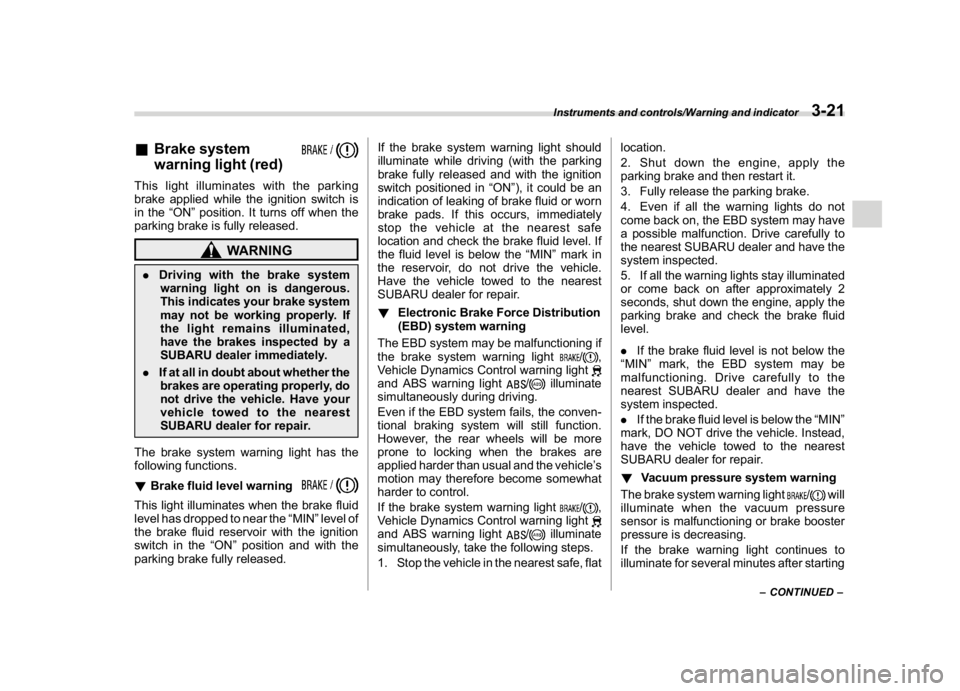
(159,1)
北米Model "A1320BE-C" EDITED: 2017/ 10/ 10
&Brake system
warning light (red)This light illuminates with the parking
brake applied while the ignition switch is
in the“ON”position. It turns off when the
parking brake is fully released.
WARNING
.Driving with the brake system
warning light on is dangerous.
This indicates your brake system
may not be working properly. If
the light remains illuminated,
have the brakes inspected by a
SUBARU dealer immediately.
.If at all in doubt about whether the
brakes are operating properly, do
not drive the vehicle. Have your
vehicle towed to the nearest
SUBARU dealer for repair.
The brake system warning light has the
following functions.
!Brake fluid level warningThis light illuminates when the brake fluid
level has dropped to near the“MIN”level of
the brake fluid reservoir with the ignition
switch in the“ON”position and with the
parking brake fully released.If the brake system warning light should
illuminate while driving (with the parking
brake fully released and with the ignition
switch positioned in“ON”), it could be an
indication of leaking of brake fluid or worn
brake pads. If this occurs, immediately
stop the vehicle at the nearest safe
location and check the brake fluid level. If
the fluid level is below the“MIN”mark in
the reservoir, do not drive the vehicle.
Have the vehicle towed to the nearest
SUBARU dealer for repair.
!Electronic Brake Force Distribution
(EBD) system warning
The EBD system may be malfunctioning if
the brake system warning light
/
,
Vehicle Dynamics Control warning light
and ABS warning light
/
illuminate
simultaneously during driving.
Even if the EBD system fails, the conven-
tional braking system will still function.
However, the rear wheels will be more
prone to locking when the brakes are
applied harder than usual and the vehicle’s
motion may therefore become somewhat
harder to control.
If the brake system warning light
/
,
Vehicle Dynamics Control warning light
and ABS warning light
/
illuminate
simultaneously, take the following steps.
1. Stop the vehicle in the nearest safe, flatlocation.
2. Shut down the engine, apply the
parking brake and then restart it.
3. Fully release the parking brake.
4. Even if all the warning lights do not
come back on, the EBD system may have
a possible malfunction. Drive carefully to
the nearest SUBARU dealer and have the
system inspected.
5. If all the warning lights stay illuminated
or come back on after approximately 2
seconds, shut down the engine, apply the
parking brake and check the brake fluid
level.
.If the brake fluid level is not below the
“MIN”mark, the EBD system may be
malfunctioning. Drive carefully to the
nearest SUBARU dealer and have the
system inspected.
.If the brake fluid level is below the“MIN”
mark, DO NOT drive the vehicle. Instead,
have the vehicle towed to the nearest
SUBARU dealer for repair.
!Vacuum pressure system warning
The brake system warning light
/
will
illuminate when the vacuum pressure
sensor is malfunctioning or brake booster
pressure is decreasing.
If the brake warning light continues to
illuminate for several minutes after starting
–CONTINUED–
Instruments and controls/Warning and indicator
3-21
3